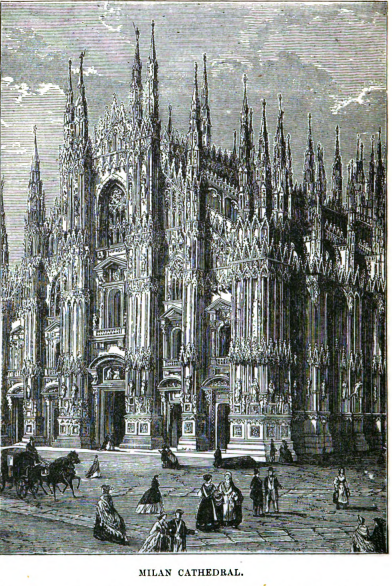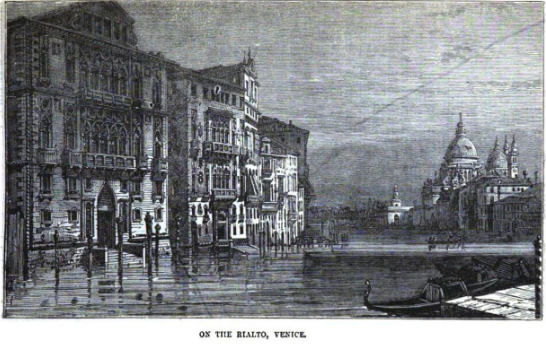After nearly a decade of working in Athens, Mary took a much deserved holiday to Italy. On August 21, 1842, Mary headed to Italy with Dr. and Mrs. Hill, along with Elizabeth of Crete, and assistant in the mission.
I cannot tell you, my sister, how much I feel my mind enlarged by all that I saw in Italy. I now feel my interest in reading, whether it be religious, or purely literary, enhanced tenfold.
Mary Briscoe Baldwin (Pitman, 1880, p.82)
Even on holiday, Mary’s love of learning prevailed as she spent much of her trip visiting churches. This section allows you to explore Mary’s trip to Italy in her own words.
Milan Cathedral
At Milan we quickly made our way to the Cathedral. This wonderful building is ornamented on its exterior with a hundred pinnacles and three thousand marble statues, which certainly give it a singular appearance. Its large painted glass windows, representing Scripture history, interested and astonished us exceedingly; but the most wonderful relic in this cathedral, is the body of Cardinal Charles Borromeo, which is preserved in a subterranean chapel. Having obtained (as is necessary) an especial permission to visit this chapel, we were shown into it by a very interesting young deacon. We passed through an ante-chapel made entirely of precious marble, and the ceiling supported by marble columns; but what was our astonishment on entering the inner chapel! A room large enough to contain fifty persons,—the walls and ceilings of which were entirely covered with gold, plated with silver, and beautifully carved. The plating of silver, we were told, was put on to conceal the real value of the chapel. When we had examined the rich walls, the deacon took from a small table near the sarcophagus of the Cardinal (who, by the way, was one of the first founders of Sunday schools,) his surplice, or white cape, which they always wear when performing any sacred duty, and put it on. Then, in a very reverential manner, he opened the massive silver sarcophagus by turning a screw, and presented to our view the very body of St. Charles Borromeo, embalmed, and enclosed in a crystal coffin . The corpse was dressed in the richest costume, having various trinkets and other precious offerings suspended over it. You can better imagine than I can describe, my sensations at seeing for the first time an embalmed body, and in addition to this awful sight, the incongruity of a human skeleton, clothed in rich apparel and adorned with precious stones. Milan is a beautiful city, and is said to resemble Paris so much that the one gives you a good idea of the other.
Mary Briscoe Baldwin (Pitman, 1880, p.83)

St. Peter’s
On Saturday afternoon, about three o’clock, we arrived at Rome. As we approached the city, we all anxiously watched to catch our first glimpse of St. Peter’s. I could not really realise that I was about to enter that ancient city ,—formerly mistress of the world, but it was so , and we drove up to the gate Del Popolo with very mingled feelings […] .
We drove to the hotel d’ Europe, on the Piazza Di Spagna, and remained quiet at home, in order to be refreshed for the coming Sabbath . After attending Divine service we walked to St. Peter’s to get a little idea of its magnitude. I feel that no description can convey an idea of this wonderful edifice. To give you an idea of its immensity, I will tell you that each pillar is ornamented at its base with marble statues representing infants, and so they appear to be when you stand at a short distance off, but when you approach them, you find that they are much larger than a big fat man, and so much larger is every part of it than it appears to be. The bronze statue of St. Peter has his foot all worn away by kisses; but our reverence was not sufficient to move us to worship his holiness thus.
Mary Briscoe Baldwin (Pitman, 1880, p.90)
The Coliseum
We determined to avail ourselves of the bright moonlight to visit again the Coliseum, which appears to much greater advantage by moonlight; indeed, one who has seen it by moonlight will not care to see it again by the light of the sun. It is a sight to be seen and felt but not to be described, for it is indescribable. We visited again for the third time the Vatican, and examined the celebrated frescoes of Raphael. On the ceiling there are fifty -two scenes of Old and New Testament story, executed in fresco by Raphael, and by others under his direction, and according to his own designs. We visited also the Borgia rooms, containing many fresco paintings; the library, a long room with galleries branching off from the far end just a quarter of a mile in length! Beside books and manuscripts this library contains many curious things. We also saw the chambers of Raphael containing many of his fresco paintings, and the gallery of paintings on canvas, amongst which are some of Raphael’s masterpieces.
Mary Briscoe Baldwin (Pitman, 1880, p.92)

Naples
We arrived at Naples on the 29th October, and
Mary Briscoe Baldwin (Pitman, 1880, p.94)
took up our abode at a hotel, immediately on the wharf, from which we enjoyed a full view of the beautiful bay of Naples. The holy Sabbath opened upon us beautiful and bright. We attended church at the palace of the British Minister, and to our comfort found that the ordinance of the Lord’s Supper was to be administered, of which we partook, with joy and thankfulness. Our stay at Naples being limited to the 5th of November in order to meet the steamer at Malta, which would convey us to Athens, we did not see so much of Naples and its vicinity as we desired. However we made the best possible use of our time. The city is large and exceedingly populous, and altogether modern in appearance. The principal places of historical interest are found in its vicinity. The only places of particular interest we visited in the city were the Museum and the tomb of Virgil. The latter is over a grotto of a mile in length, cut through the rock, and through which we drove, whenever we went out of the city in that direction.
Venice
Venice, as you know, has no ports, being built on a collection of small islands, and intersected by canals and waterways in place of streets. So we came to anchor near the hotel at which we put up, called The Europe. The steamer was immediately surrounded by gondolas, and the busy scene which followed was most amusing to us, so we waited until we had seen most of the passengers take possession of their gondolas and grace fully glide off. The morning was beautiful and bright. I felt an indescribable sensation come over me to think that I had actually arrived at Venice. Although I had seen models and sketches of the gondola, I had never heard that the covered part in the centre is always painted black, consequently I was struck with the resemblance to a hearse. On inquiry, I was told that in former days the Venetians went to such extremes of extravagance in the decoration of their gondolas, that one of the Doges issued an order that they should all be covered with black cloth. The covers, which have glass windows like carriages, are made to slide on and off, so that they are removed at pleasure, and in pleasant weather are seldom used. After a little rest and refreshment, we summoned a guide with a gondola, in order to take us to those places usually visited by travellers.
Mary Briscoe Baldwin (Pitman, 1880, p.79)

Pompeii
[W]e visited Pompeii, where we spent the day. It is two hours and a half distant from the city: on our arrival thither we wandered through the silent streets and houses for four hours before we were aware how the time had passed, so deeply were we all interested in what we saw. There the pleasure we enjoyed was solemn. There we felt, indeed, the force of the many passages of Scripture which tell us of the vanity of all earthly things, and of the uncertainty of life. In the house of Diomedes, a wealthy and distinguished individual of the year 79, we saw in the wine-cellar, where the family fled for refuge from the destroying element, the impression of a female head and shoulders on the wall, made by the molten lava and ashes, in which she was enveloped, and from which she could not escape. Just as she was buried in that year, standing with her purse in her hand, she was recently disentombed: it is supposed she was the wife of Diomedes. It was easy to distinguish the different houses by their style and furniture. We went into palaces, hotels, shops, and private houses. It is literally a city of the dead.
The temples and theatres were very interesting. A large part of the city is excavated, and they are continuing the work. All movable things are carried to the Museum at Naples, which is no doubt necessary for their preservation, but it would be much more interesting to see them on the spot. In the Museum, we saw a large quantity of frescoes excavated from the buried city, and also a multitude of household furniture of all kinds, all of which was made either of bronze or earthenware. We saw also eatables of various kinds, such as eggs, bread, fruit, and honey, all charred, excepting the eggs, which looked natural. The bread was a whole loaf, with the baker’s name on it. We saw also many jewels and precious stones, which once adorned the ladies of Pompeii. You may imagine with what interest we looked at these things. When we had seen them all, we could but re mark that there was nothing new under the sun. These long-buried folks of the first century, seem to have had all the conveniences of housekeeping which we enjoy.
Mary Briscoe Baldwin (Pitman, 1880, p.94)
Go to previous section, Life Athens
Go to next section, Life in Joppa
Pitman, E. R. (1880). Mission Life in Greece and Palestine: Memorials of Mary Briscoe Baldwin, Missionary to Athens and Joppa. Cassell, Petter, Galpin & Co.